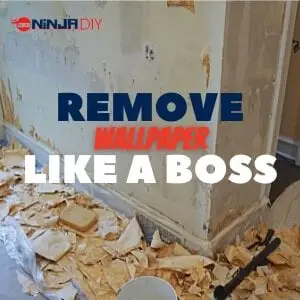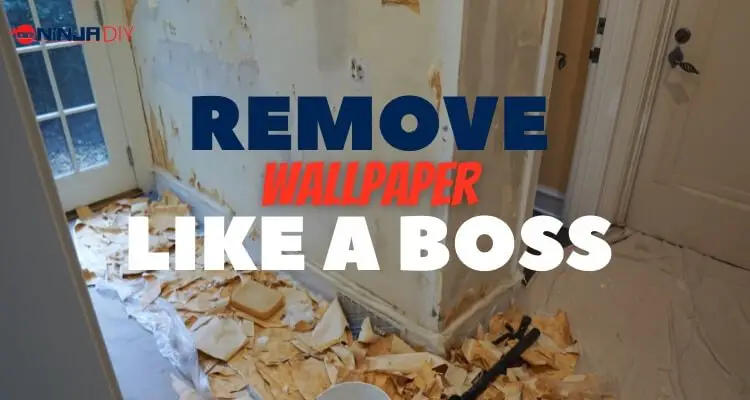If you’ve always wanted to get rid of that ugly wallpaper off your drywalls but were worried about tearing a hole into it, then today’s your lucky day.
To remove your wallpapers and start from scratch you will need to:
- Gently perforate the wallpaper with a scoring tool or putty knife
- Steam off the glue with a steamer to soften the wallpaper’s glue
- If you don’t have a steamer, use a mixture of water & vinegar or fabric softener to break down the wallpaper’s glue
- Carefully scrape and peel off the wallpaper
- Use baking soda and water mixed with detergent to rub away leftover glue
- Clean up residual dirt or paste left on the drywall
- After the wall dries, finish up by sanding, repairing, and priming the wall
Keep reading to find out the best DIY ways to remove wallpapers.
Prepping up your workspace
Like any other DIY renovation or fixup job, preparation is vital to make things go smoothly and according to plan. Before you start removing wallpapers, make sure to:
Empty the room
Before you begin, you should clear the area you’ll be working in and remove any object that can get in the way or get dirty.
Cut the power
Make sure to turn off the electricity in the room you’ll be working to avoid getting electrocuted.
Cover up outlets
Remove all light switches and cover up the openings with plastic. Doing this will prevent water from seeping into them to avoid a short circuit.
Perforate the wallpaper
Use a kitchen knife or putty knife to gently cut lines into the wallpaper. Cutting the lines will allow the moisture to penetrate through the adhesive between the drywall and the wallpaper.
If you happen to have a wallpaper scoring tool, use it in a circular motion to perforate the wallpaper.
In either case, don’t press too hard on the wall.
Otherwise, you could damage and cut into the wall itself.
Protect the floor
Depending on what material the floor is made of (laminate flooring, epoxy, etc) excess water spills can ruin the floorboard. For this reason, you will need to line the floor with plastic or cloth sheets and tape them to the edges of the wall.
Wear protection
Safety comes first!
Old wallpaper can contain dried-up fungus, which can get into the air you’re breathing. Along with debris and particles which could get in your eyes. Including hot water and other elements from the removal process.
Removing wallpaper from drywall
Stripping off wallpaper is easy; however, the same can’t be said about the glue that binds it to the drywall.
The adhesive material used to make wallpapers stick to walls lasts for several years. Meaning that if you try to peel off the wallpaper immediately, it’ll be like removing a label off a jar.
You will have stubborn areas that won’t budge or ruin the drywall itself.
Luckily, all it takes is a few household items to get the job done right, and quickly at that too.
Things you’ll need:
- Steamer
- Wallpaper scoring tool or kitchen knife
- Putty knife
- Bucket
- Spray bottle or paint roller
- Baking soda
- Detergent
- Fabric softener
- Vinegar
- Sandpaper
- Sponge
- Protective gear (gloves, goggles, mask)
- Cloth rags or plastic sheets
How to remove wallpaper with a steamer
Fill a steamer with water and wait for it to heat up; alternatively, use a cloth iron and put it in steam mode.
Once the water has become hot, place the steamer or cloth iron on the wallpaper for a minute or two. You will start to see the wallpaper wrinkle up or slide off. When the wallpaper becomes loose, scrape it off with a putty knife.
Repeat the same steps for any residue wallpaper on the wall.
The trick behind this method is that moisture from the steamer or cloth iron will penetrate through the cuts you’ve made into the wallpaper. Allowing the hot steam to soften up the glue.
Remember, the longer you steam the wallpaper, the less time you’ll have to spend scraping stubborn parts that didn’t come off the first time.
Keep in mind that if you use a cloth iron, you should wear rubber gloves. Gloves will protect you from any scorching water that could splash on your hands.
You should also wear shoes that’ll not let you lose your grip on the floor. The last thing you want is a heated object falling from its weight on you. Especially since you’ll be holding the cloth iron vertically with nothing but your arms to support it.
How to remove wallpaper with vinegar or fabric softener
Inexpensive white vinegar or fabric softener can also double as your DIY partner in crime.
Start by mixing equal quantities of vinegar or fabric softener with warm water in a spray bottle.
While a spray bottle will let you cover the most significant amount of area in a shorter amount of time. You can also use a sponge or paint roller to apply the solution onto the wall.
Next, generously apply the solution to the perforated wall and let it soak for up to 20 minutes.
Once the wallpaper starts to soften up, grab a part of it from the corners and begin pulling off sections. If the wallpaper is still stuck on the wall, apply more water mixed with vinegar or fabric softener. Also use a putty knife to scrape away the wallpaper.
Remember not to rush!
Do not immediately start scraping. Since the wallpaper needs to soak up the solution before you can start scraping. If at any point a section of your wall isn’t absorbing the solution.
Then run a knife on the wall or use a scoring tool, then more of the solution.
How to remove wallpaper glue residue from drywall
After removing the initial layer of wallpaper, some glue might need a different approach to get rid of it.
In a bucket, combine dishwashing soap with water and a tablespoon of baking soda. For glue that’s stubborn, add white vinegar to the mix – 1 cup per gallon of water.
Next, grab a sponge and apply the mixture to a small section of the wall. Wait for about 15 minutes for the solution to break down the glue.
Now start rubbing the wall with a sponge until the glue starts to come off. If the glue isn’t coming off, apply more of the mixture as needed until it’s thoroughly soaked.
For the best results, work on one section at a time so that you can remove the glue while it’s still soft. Otherwise, it’ll start to harden up again.
When the glue is removed, wipe the walls in a circular motion with a clean damp cloth, dry the walls with another rag.
Then leave the wall to aerate for around 24 hours.
How to remove wallpaper from unprimed drywall
If you glue wallpaper onto the drywall and there’s no primer in between, things can get messy. Especially if it’s an older wall.
If you try to separate the wallpaper from it, you’ll end up removing the outer layer of the drywall’s paper coating.
The trick here is to have patience.
Wait for the wallpaper to soak up. Wait using either the steamer or vinegar/fabric softener-based after scoring the wall. Only once the wall starts to form bubbles can you begin scraping away.
To avoid peeling off parts of the wall, use a putty knife with minimal pressure to strip off the wallpaper.
What to do after removing the wallpaper from the drywall?
With your drywall now wallpaper-free, it’s time to take care of the finishing touches.
Your wall might seem ready at this stage. But the residue of the old wallpaper and the resulting uneven patches can cause your new wallpaper or coating of paint to look off or peel over time.
After removing the old wallpaper, make sure to:
1. Clean the wall
As clean as your wall looks after scraping away the old wallpaper. Leftover paste and primer will eventually dry up and form a new layer on your wall. The new layer will ruin any new coating.
Making it essential to wash your wall with a sponge and detergent mixed with water. Once you’re done scraping to see the final results.
2. Sand the wall
Inevitably, some paper will remain on the drywall and cause the surface to be uneven.
To overcome this, once the wall is fully dry, smoothen the drywall’s surface lightly with sandpaper. If your wall is textured, sand it delicately not to damage the texture.
3. Patch the wall
If parts of the wall get chipped or damaged in the removal process, apply joint compound mud with a putty knife (or a bazooka drywall taper if you have one)
It will fill in any cracks or spaces. If any lines appear, use a light coating of joint compound mud on the entire wall to give it an even finish.
4. Prime the wall
After smoothing out the wall and removing any underlying paper, coat the drywall with latex primer. It will prevent the wall from absorbing moisture. The primer will also act as a new layer for your paint or wallpaper to hold on to.
Wrapping up this DIY project removing wallpaper from the walls
Completely removing wallpaper can be a time-consuming process.
Still, if you follow these steps, it should be pretty straightforward. It’s only a matter of a few days until you can go from stripping away the old wallpaper to enjoying a new look on your walls.
To wrap this up, remember to have patience throughout the process to get the best results. Otherwise, you’ll have to figure out how to install new drywall and go into an even more challenging job to repair the damage.
When you could have avoided it by not rushing things while removing the wallpaper.
Ninja Team Members Working On This Page

Adrian – WebMaster / Construction Professional
Construction Professional, driver, crane operator, handyman … As a construction pro I love to get creative and see things done with my hands coming to life. Here I share with you some of the things I learn and hopefully you’ll get something out of it. Enjoy 🙂



